The Resuscitation Bags Market is estimated to be valued at USD 538.0 million in 2025 and is projected to reach USD 737.2 million by 2035, registering a compound annual growth rate (CAGR) of 3.2% over the forecast period.
| Metric | Value |
|---|---|
| Resuscitation Bags Market Estimated Value in (2025 E) | USD 538.0 million |
| Resuscitation Bags Market Forecast Value in (2035 F) | USD 737.2 million |
| Forecast CAGR (2025 to 2035) | 3.2% |
The Resuscitation Bags market is experiencing steady growth, driven by the increasing demand for emergency respiratory support devices in hospitals and healthcare facilities worldwide. Rising incidences of respiratory disorders, critical care requirements, and emergency medical interventions are contributing to the market expansion. Technological advancements in bag design, ergonomics, and patient safety have enhanced the efficiency and reliability of resuscitation procedures.
Disposable and reusable options are being adopted to meet varying clinical needs while minimizing infection risks and ensuring compliance with hygiene standards. The market is further supported by the integration of lightweight, durable, and biocompatible materials that improve usability for healthcare professionals. Increasing investments in healthcare infrastructure, emergency preparedness programs, and critical care training are creating additional demand.
Regulatory emphasis on patient safety, quality standards, and device certification is driving the adoption of compliant resuscitation solutions As hospitals and emergency care centers prioritize efficiency and operational readiness, the Resuscitation Bags market is expected to maintain sustained growth, with innovation in material selection and usability shaping the competitive landscape.
The resuscitation bags market is segmented by bag type, material type, end use, and geographic regions. By bag type, resuscitation bags market is divided into Disposable Resuscitation Bags and Reusable Resuscitation Bags. In terms of material type, resuscitation bags market is classified into Silicon, Rubber, and PVC. Based on end use, resuscitation bags market is segmented into Hospitals and Ambulances. Regionally, the resuscitation bags industry is classified into North America, Latin America, Western Europe, Eastern Europe, Balkan & Baltic Countries, Russia & Belarus, Central Asia, East Asia, South Asia & Pacific, and the Middle East & Africa.
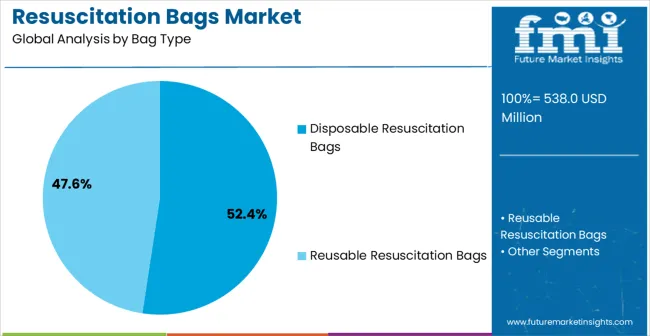
The disposable resuscitation bags segment is projected to hold 52.4% of the market revenue in 2025, establishing it as the leading bag type. Its growth is being driven by the increasing focus on infection control and patient safety, particularly in high-volume hospitals and emergency care settings. Disposable bags reduce the risk of cross-contamination and eliminate the need for cleaning and sterilization, making them highly suitable for intensive care units, emergency rooms, and transport scenarios.
The lightweight design and user-friendly operation enhance efficiency for healthcare professionals during critical interventions. Manufacturing advancements in materials and ergonomics have further strengthened adoption, enabling consistent performance and reliability.
The cost-effectiveness achieved through reduced maintenance and infection-related complications reinforces preference for disposable bags As hospitals continue to emphasize hygiene, operational efficiency, and rapid response capabilities, the disposable resuscitation bags segment is expected to maintain its leadership position, supported by ongoing innovation in design, material composition, and usability.
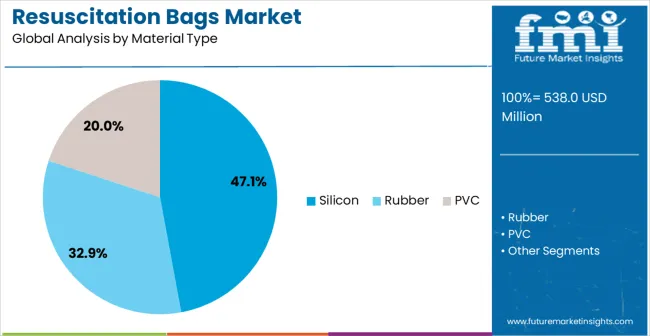
The silicon material type segment is anticipated to account for 47.1% of the market revenue in 2025, making it the leading material category. Growth in this segment is driven by the high flexibility, durability, and biocompatibility offered by silicon, which ensures reliable performance during repeated usage and under varying clinical conditions. Silicon resuscitation bags provide superior sealing and resilience, maintaining consistent airflow and patient safety during critical interventions.
The material’s lightweight and non-toxic characteristics enhance ease of handling for healthcare providers. Its chemical stability and resistance to high-temperature sterilization enable compliance with hygiene standards and regulatory requirements.
Rising awareness among hospitals regarding material performance, patient safety, and infection control has further fueled adoption As healthcare facilities continue to prioritize high-quality and reliable resuscitation equipment, silicon-based bags are expected to remain the preferred choice for medical professionals, driving continued market growth in both routine and emergency care settings.
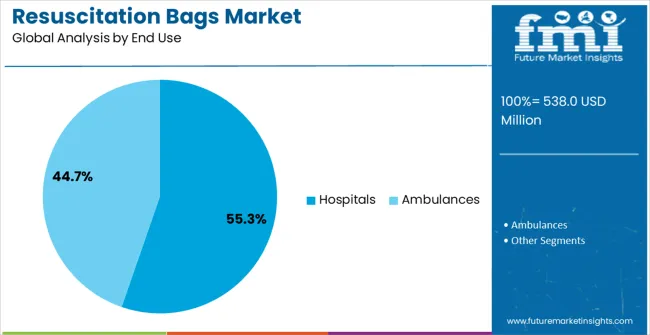
The hospitals end use segment is projected to hold 55.3% of the market revenue in 2025, establishing it as the largest end-use category. Growth in this segment is being driven by the high volume of emergency, surgical, and critical care procedures requiring immediate respiratory support. Hospitals increasingly demand resuscitation bags that offer reliability, ease of use, and compliance with patient safety and infection control standards.
Integration of disposable and silicon-based bags ensures operational efficiency and reduces the risk of cross-contamination. Increasing investments in hospital infrastructure, critical care training, and emergency preparedness programs are supporting segment growth.
The ability to rapidly deploy resuscitation solutions across emergency departments, intensive care units, and transport facilities further reinforces adoption As the need for timely and effective patient intervention continues to rise, hospitals are expected to remain the primary drivers of demand for resuscitation bags, with technology and material advancements strengthening their position as the leading end-use segment in the market.
The increasing prevalence of cardiac arrest in recent years has augmented the need for innovative solutions to address shortages in crucial medical equipment. Cardiac arrest is the most noteworthy cause of mortality and morbidities worldwide. An improved understanding of the pathophysiology in post-resuscitation care has been proposed by numerous resuscitation councils throughout the globe.
A new-fangled initiative from a global team of biomedical engineering experts has presented a perfect example. The team developed a technique for resuscitation bags – common pieces of equipment carried by ambulances and paramedics around the world, and normally in strong supply at hospitals to be remodeled as emergency ventilator hardware.
Future Market Insights’ recent forecast report reveals that worldwide organizations are coming together to minimize the chances of cardiac arrest cases and enhance lives. The American Heart Association is working in partnership with the World Health Organization to reduce premature death due to non-communicable diseases.
The goal of the initiative is to decrease the burden of non-communicable diseases by 25% by 2025, which will help to reduce the burden of cardiovascular disease and stroke globally. This is projected to positively influence market growth.
As per the report published by American Heart Association (AHA), about 10% of newly born infants entail assistance for breathing at birth among which a projected 1% require intensive resuscitative steps to ensure the functionality of the heart and respiration. Henceforth, effectual and required resuscitation during birth to these infants could support reduced neonatal deaths and will improve the growth of the market further.
Strict government regulations relating to manual resuscitator use and manufacturing are likely to hinder the growth of the market throughout the forecast period. The market is highly controlled by the World Health Organization. For instance, WHO offers the technical specifications for the manufacturing of manual resuscitators.
Witnessing the immense growth prospects in regions like North America and Europe, several players are utilizing these opportunities by developing advanced respiratory types of equipment. For instance, Mercury Medical provides Airway Management Devices for use in anesthesia, emergency, and critical care.
The company also provides Biomedical equipment rental and repair services. The company's portfolio of respiratory devices includes oxygen sensors, CPAP devices, airway clearance devices, laryngoscopes, reusable and disposable airways, CPR bags, nebulizers, resuscitators, and associated services. The company provides its products and services in the US and worldwide through a network of distributors.
With the increasing application in multi-specialty centers and hospitals, the growth rate for resuscitator bags is likely to upsurge over the years to come, states Future Market Insights report.
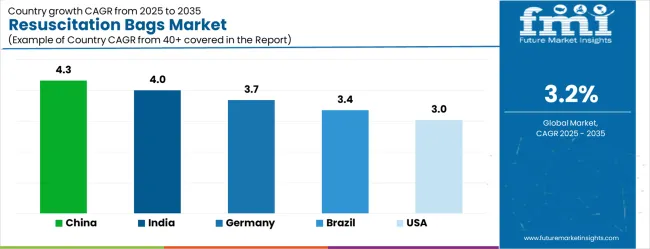
| Country | CAGR |
|---|---|
| China | 4.3% |
| India | 4.0% |
| Germany | 3.7% |
| Brazil | 3.4% |
| USA | 3.0% |
| U.K. | 2.7% |
| Japan | 2.4% |
The Resuscitation Bags Market is expected to register a CAGR of 3.2% during the forecast period, exhibiting varied country level momentum. China leads with the highest CAGR of 4.3%, followed by India at 4.0%. Developed markets such as Germany, France, and the U.K. continue to expand steadily, while the U.S. is likely to grow at consistent rates. Japan posts the lowest CAGR at 2.4%, yet still underscores a broadly positive trajectory for the global Resuscitation Bags Market. In 2024, Germany held a dominant revenue in the Western Europe market and is expected to grow with a CAGR of 3.7%. The U.S. Resuscitation Bags Market is estimated to be valued at USD 198.4 million in 2025 and is anticipated to reach a valuation of USD 198.4 million by 2035. Sales are projected to rise at a CAGR of 0.0% over the forecast period between 2025 and 2035. While Japan and South Korea markets are estimated to be valued at USD 28.6 million and USD 13.6 million respectively in 2025.
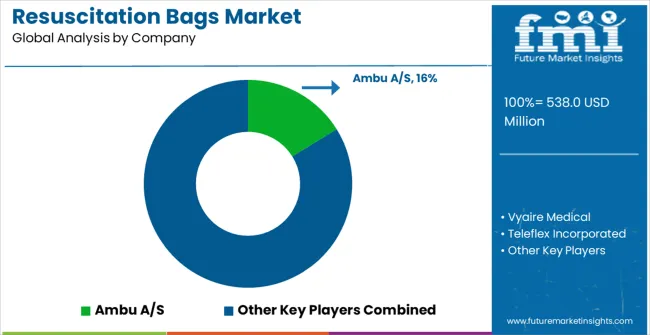
| Item | Value |
|---|---|
| Quantitative Units | USD 538.0 Million |
| Bag Type | Disposable Resuscitation Bags and Reusable Resuscitation Bags |
| Material Type | Silicon, Rubber, and PVC |
| End Use | Hospitals and Ambulances |
| Regions Covered | North America, Europe, Asia-Pacific, Latin America, Middle East & Africa |
| Country Covered | United States, Canada, Germany, France, United Kingdom, China, Japan, India, Brazil, South Africa |
| Key Companies Profiled | Ambu A/S, Vyaire Medical, Teleflex Incorporated, Medtronic plc, Laerdal Medical, Smiths Medical, Hersill, Intersurgical, Weinmann Emergency, and Mindray Medical |
The global resuscitation bags market is estimated to be valued at USD 538.0 million in 2025.
The market size for the resuscitation bags market is projected to reach USD 737.2 million by 2035.
The resuscitation bags market is expected to grow at a 3.2% CAGR between 2025 and 2035.
The key product types in resuscitation bags market are disposable resuscitation bags and reusable resuscitation bags.
In terms of material type, silicon segment to command 47.1% share in the resuscitation bags market in 2025.






Full Research Suite comprises of:
Market outlook & trends analysis
Interviews & case studies
Strategic recommendations
Vendor profiles & capabilities analysis
5-year forecasts
8 regions and 60+ country-level data splits
Market segment data splits
12 months of continuous data updates
DELIVERED AS:
PDF EXCEL ONLINE
Resuscitation Trolley Market
Polybags Market Size and Share Forecast Outlook 2025 to 2035
Net Bags Market
VCI Bags Market
Sandbags Market
Leno Bags Market Size and Share Forecast Outlook 2025 to 2035
Silo bags Market Size and Share Forecast Outlook 2025 to 2035
Food Bags Market Share, Size, and Trend Analysis for 2025 to 2035
Competitive Breakdown of Silo Bag Manufacturers
Paper Bags Market Size and Share Forecast Outlook 2025 to 2035
Jumbo Bags Market Size and Share Forecast Outlook 2025 to 2035
Blood Bags Market Size and Share Forecast Outlook 2025 to 2035
Craft Bags Market Growth, Trends, Forecast 2025 to 2035
Market Share Breakdown of Craft Bags Manufacturers
Competitive Breakdown of Paper Bags Providers
Market Share Analysis of Jumbo Bags & Key Players
Grout Bags Market Demand & Construction Industry Trends 2024 to 2034
Sugar Bags Market
Cotton Bags Market Size and Share Forecast Outlook 2025 to 2035
Refuse Bags Market Size and Share Forecast Outlook 2025 to 2035

Thank you!
You will receive an email from our Business Development Manager. Please be sure to check your SPAM/JUNK folder too.
Chat With
MaRIA